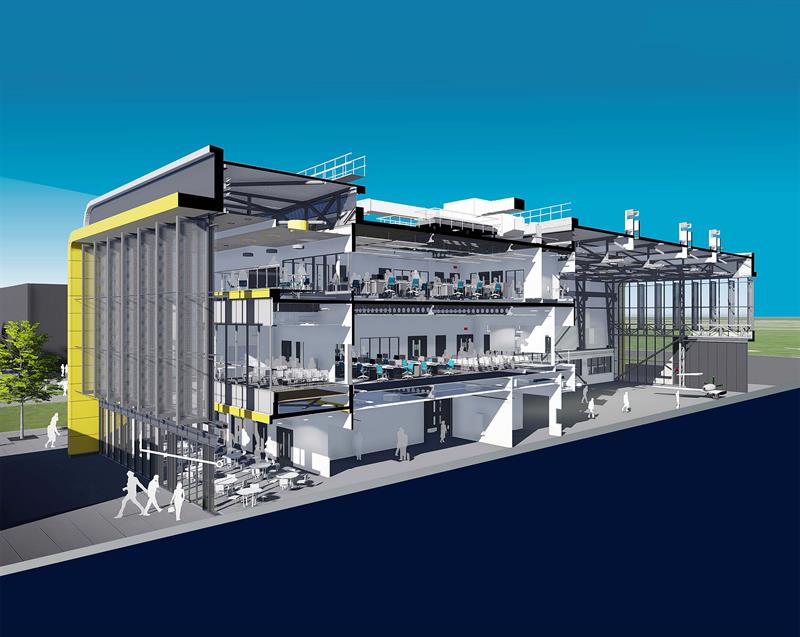This is why Airbus and Rolls-Royce are breaking the mould by working on many of their biggest R&D projects in the same building. This has opened up new kinds of collaboration.
For example, the two aerospace giants are now able to work together in areas where engine and air frame makers have traditionally not agreed. These have included the thorny issue of what information pilots really need to be given on the aircraft performance, leading to unnecessary strains on engines and more maintenance needs; and a project using a full-scale A320 wing to test for the most efficient engine positioning; and test rig to provide data and models as the basis for any futuristic aircraft designs.
This process originally came about when Airbus and Rolls-Royce bosses said their engineers will work closer than ever before after the opening of the Aerospace Integration Research Centre (AIRC) at Cranfield University. In fact, heads of the companies hailed a “new paradigm of collaboration” when they officially launched the £35m research centre.
Research in the centre includes work on unmanned aerial vehicle (UAV) flight patterns, fibre-optic sensing technology for helicopter blades and automated manufacturing of aeroplane parts.
“The word collaboration is absolutely key for everyone involved,” says Cranfield director of aerospace, Iain Gray. “It’s looking at how you work together… to meet environmental goals, to meet logistics goals, cost and performance value.”
Researchers, some of whom are pilots themselves and can test technology in-flight by taking off from the adjacent airport and work alongside engineers from the partner companies in the centre.
Funded by Airbus, Rolls-Royce and Cranfield University, following an award from the Higher Education Funding Council for England (HEFCE), the Centre will be a flagship facility for boosting aerospace research capabilities in the UK, cementing the University’s reputation as the leading aerospace research institution in Europe.
Researchers from both the University and business partners, including Airbus and Rolls-Royce, will work under one roof. The Centre will be researching ways of integrating advanced technologies to reduce the time from academic innovation to industrial application.
 To enable this, the AIRC is equipped with the latest cutting-edge aerospace research technology including air traffic management (ATM) and unmanned aerial vehicle (UAV) laboratories; flight simulators; a virtual wind tunnel; a Fanuc robot in the intelligent automation centre; and a 1500m2 open space work area, currently housing a full-size wing from an Airbus plane.
To enable this, the AIRC is equipped with the latest cutting-edge aerospace research technology including air traffic management (ATM) and unmanned aerial vehicle (UAV) laboratories; flight simulators; a virtual wind tunnel; a Fanuc robot in the intelligent automation centre; and a 1500m2 open space work area, currently housing a full-size wing from an Airbus plane.
Professor Sir Peter Gregson, vice-chancellor and chief executive, Cranfield University, said: “Facilities such as the AIRC mean Cranfield is at the forefront of changing the way the world thinks about flight. Greater integration between research and world-renowned businesses provides us with the opportunity to tackle some of aerospace’s grand challenges by providing the technologies, facilities and skills that are needed to succeed.”
Trevor Higgs, head of landing gear and UK senior site representative, Airbus, said: “We at Airbus see the AIRC as a key part of the growing research ecosystem the aerospace industry has in the UK, and will help us foster closer relationships with research partners and to accelerate and deliver on our research strategy for the Wing of Tomorrow, to make sure our products remain the best in world.”
Henner Wapenhans, director of technology strategy, Rolls-Royce, added: “We are delighted to be a lead partner with Airbus in the Aerospace Integration Research Centre, which will also strengthen the existing strategic partnership between Rolls-Royce and Cranfield University.
“This new Centre will help develop the next generation of highly skilled engineers and will play an important role in developing the innovative technologies needed to enhance performance, improve efficiency and reduce emissions of future aircraft.”
David Sweeney, director (research and knowledge exchange), HEFCE, said: “The AIRC is an excellent example of the government’s industrial strategy in action, linking research to industry needs which is what the UK Research Partnership Investment Fund supports.The high-class facilities and the world-leading research at Cranfield University will contribute directly to the growth of the aerospace industry and the wider UK economy.”
Cranfield is the only university in Europe that brings together major aerospace research facilities such as the AIRC, an operational airport and runway on one connected site.
One of the AIRC’s unique features is its focus on integration, where new aerospace technologies are rapidly developed and tested for current and future aircraft and airspace concepts.
This is supported by centre-based facilities including visualisation screens that enable the development time from idea to implementation to be shortened. It has laboratories dedicated to aerial autonomous vehicles and engineering photonics. Its 1500m2 Open Space laboratory enables research on full-scale aircraft and components, and currently includes a production standard A320 for research and validation of automated assembly techniques being developed in the Centre. It also has covered laboratories dedicated to aerial autonomous vehicles and engineering photonics applications.
Research at the AIRC also draws on the full capabilities of Cranfield University, including its on-site airport, National Flying Laboratory Centre, large scale gas turbine test area and Cranfield’s School of Management. This allows researchers to take their projects from theory to flight demonstration in one place, validating their research to technology readiness levels (TRL) 6-7 – higher than the levels normally associated with an academic environment.
Professor Iain Gray leads the aerospace capabilities across the University and their strategic relationships with the world’s major aerospace industrial organisations. Iain was chief ex-ecutive of Innovate UK (formerly known as the Technology Strategy Board) until he joined Cranfield in March 2015. Professor Gray has 27 years’ industry experience in the aerospace sector including roles at British Aerospace and BAE Systems. He held various engineering positions before taking on the roles of director of engineering, then managing director at Airbus UK. He became the first chief executive of Innovate UK following its establishment in 2007. Professor Gray completed his early education in Aberdeen, culminating in an Engineering Science honours degree at Aberdeen University. In addition, he gained a Masters of Philos-ophy at Southampton University in 1989. Since then Iain has received Honorary Doctorates from Bath, Bristol, Aberdeen, Aston and Exeter Universities in 2005, 2006, 2007, 2011 and 2012 respectively. He is a chartered engineer, a Fellow of the Royal Academy of Engineering and a Fellow of the Royal Aeronautical Society and was awarded the Royal Aeronautical Society Gold Medal in 2007. He was elected as a Fellow of the Royal Society of Edinburgh in 2011. |








 Iain Gray
Iain Gray